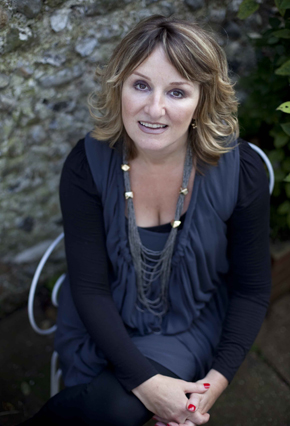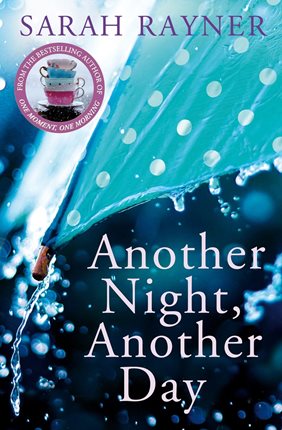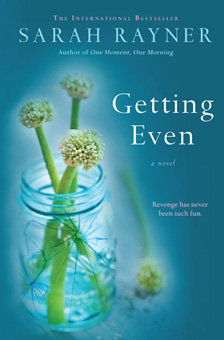Gimme a break
by Sarah RaynerWhat do Martin Amis, Don DeLillo, F. Scott Fitzgerald, Elmore Leonard, Ogden Nash, Flannery O’Connor, James Patterson, Dorothy L. Sayers and Fay Weldon have in common? Not a lot, you would be forgiven for thinking. But in fact they share a personal history; they all started out as advertising copywriters. Just like me, then, and although George Orwell may have described advertising as “the rattling of a stick inside a swill bucket” (Keep the Aspidistra Flying, 1936), I’m proud to be in such illustrious company.
I joined my first ad agency in 1989 (a small, unglamorous wing of Saatchi and Saatchi) and worked for over 20 years writing copy for clients as diverse as Anchor butter and Zurich insurance. “Don’t give up the day job,” warned my agent when I signed my first book deal back in 2000. Words I’m glad I heeded, as it took another ten years before my third novel, One Moment, One Morning (Picador, 2010) sold enough copies to allow me to make writing fiction a full-time occupation – for now, at least.
Let’s be clear from the off – this list of copywriters-turned-successful-authors should not deceive us. Broadly speaking, if it’s a career you’re after, advertising offers better opportunities. Salaries are higher – according to Creative Review, a copywriter can expect to start on £25,000 a year as a junior, whereas a recent survey by the ALCS revealed the average income of a published author is £11,000 per annum. In an ad agency the hours are regular and the chances of recognition are higher – employees are offered some kind of pole to climb, however greasy, whereas only 11.5% of authors earn their living solely by writing. Most importantly, even though the days of 1980s excess are behind us, agency parties are far more lavish. They have to impress clients, after all.
Let’s also not be fooled into thinking that just because someone is good at writing copy they’re going to make a decent novelist. Yes, Salman Rushdie came up with several classic slogans including “Naughty, but nice” for cream cakes and “Irresistibubble” for Aero before winning the Booker for Midnight’s Children in 1981. Yes, Joseph Heller’s Catch 22 was born from a copy line he came up with at Merrill Anderson in New York in 1953. But for every copywriter-turned-novelist’s happy after ever there are a thousand rejection letters from publishers. The chances of making the transition are slim.
In an ad agency you can’t let your own opinion or political convictions get in the way – no sausage manufacturer wants to hear your views on factory farming, they just want their bangers sold.”
“Writing a snappy headline or a radio spot where you mention the product name six times doesn’t mean you can sustain narrative pace and shape over 80,000 words, or develop complex characters in a textured, three-dimensional setting,” says Paula Morris, who worked as a copywriter for The New York Times in the 1990s. She is now an award-winning author (Rangatira, Penguin NZ 2012 and three YA novels including Ruined, Scholastic 2009) and teaches creative writing at the University of Sheffield, but her CV is the exception, not the rule.
Equally, writing novels doesn’t qualify someone to be a copywriter, and authors keen to supplement their income with a blast of freelancing in the ad world would do well to respect the ad(wo)man’s art. Sure, being an author has more in common with copywriting than, say, being a zoo keeper, but it’s a bit like expecting a sculptor to be good at making shelves.
There are overlaps, however, and without doubt I learned a lot from copywriting. Rushdie said advertising “taught me to write like a job. If you have the client coming in that afternoon for his new campaign, you can’t not have it. What’s more, it has to be good.” His words still ring true – when it comes to turnaround times, advertising is a hare to publishing’s tortoise. Agencies are much more responsive – they have to be – if one supermarket alters their prices, another will follow, and this has to be communicated to consumers, fast, so when a client said “jump”, as a copywriter I got used to jumping. Ads can be turned round for newspapers in hours, radio ads made in a day.
Not so a novel. Whilst self-publishing and e-books are altering the landscape, it remains common for the big publishing houses to have a long gap between delivery and publication. This is not without reason, as my editor at Picador, Francesca Main explains: “Although books can be turned around in a matter of weeks in exceptional circumstances (a self-published ebook bestseller being rushed into print, say, or a non-fiction book about a particularly timely subject), our ideal lead-time in publishing is around a year between acquisition and publication. Not only does this enable the author and editor to work together on making the manuscript the very best it can be, it also allows for the sales, marketing, design and production processes. Our sales team first presents a book to retailers up to nine months ahead of publication, and a long lead-time is essential when it comes to building early buzz and word-of-mouth.”
“One thing copywriting won’t train you for is the patience required as an author,” says Laura Wilkinson. “Possibly the most useful thing that writing fundraising scripts for Amnesty International and Barnado’s taught me is an understanding of story arc and how to condense it into a few short sentences. It’s a useful skill when it comes to the sticky process of writing synopses.” She describes her latest novel Public Battles, Private Wars (Accent Press, 2014) as “about a young miner’s wife on the rocky journey to fulfilment and love, set against the backdrop of the 1984–85 strike,” and says that “for campaign materials I had to entice the reader in – create the hook in fictional terms – then outline the problem, explain the charity’s objectives and the obstacles to them achieving those goals and how to overcome them. In fiction you need to do something similar to test the strength of your plot.”
R.S. Pateman (The Second Life of Amy Archer, Orion, 2013) is another author who cut his teeth copywriting. “I spent many years in Direct Marketing and got into the habit of introducing a benefit, making a call to action, then moving onto another benefit, another call to action and so on,” he says. “I learned how to keep a thread going and develop an argument without losing sight of the overall story. Yet whilst DM helped me with plotting, it didn’t do much for concision – a four-page letter gave me too much room to wax lyrical. It was writing web copy that taught me to be more concise.”
“In teaching creative writing, I use limited-word exercises all the time,” says Morris. “Students learn how to be precise, ensure words earn their place on the page, use strong verbs rather than relying on strings of adjectives, and make something vivid without droning on. But while copywriting helps you develop a facility with language, it doesn’t address the key aspects of technique in fiction such as point of view, narrative structure and setting.”
Nor does copywriting teach you to have a voice or get inside the head of a character the way a novelist has to. Prior to their re-issue by Picador in 2013, I revisited my first two novels, The Other Half and Getting Even, which were originally published by Orion in 2001 and 2002 respectively. I was struck by how different they were from how I write now. Back then I had more distance from my protagonists – too much so. With hindsight it felt as if I was controlling them like puppets, and I revised both books extensively. The new versions have more show and less tell and I hope both are more engaging as a result.
Over the years I’ve learned to let go as an author and put my heart and soul into creating my characters. I’ve also grown more confident about saying what I believe. My new novel, Another Night, Another Day (Picador), focuses on three people who meet in a psychiatric clinic and is my most personal and political to date. It explores mental illness, of which I have some experience, and doesn’t pull its punches on the impact that government cuts in expenditure have had on the NHS. In an ad agency you can’t let your own opinion or political convictions get in the way – no sausage manufacturer wants to hear your views on factory farming, they just want their bangers sold. A copywriter tends to be too bound by the need to sell a product and brand guidelines to develop his or her own voice.
I’ve also learned how to hook a reader – “cherry on the top of the cake” was something I was told by my first boss when writing a press release, and the same could be applied to the opening of a novel. Both have to capture the attention of the reader at once, and compel them to read more.
Advertising also taught me to empathise with a reader. Every item of marketing collateral will have a specific target audience, and when writing a piece of copy I’d always have someone in mind. Sometimes it might be a whisky drinker in his sixties, at others a budget-conscious parent of small children, but I was never simply writing into an abyss.
One can go too far in this regard, argues Morris. “Perhaps the thing that needs to be unlearned, to an extent, is the focus on an audience, or the emphasis placed on a product’s name or a call to action. Fiction is more subtle. You’re writing for unknown readers, possibly in another country, even possibly in another era. The focus is on the art and craft of the thing, rather than market segment – chasing the market is a loser’s game when you’re writing a novel. It may take you a year or three to write it, then another year for it to come out. You’re not writing to a client’s brief: you’re writing because you have a story to tell, and hopefully something to say, and an overall artistic vision that will see you through the dark times and help you revise and actually finish your creation.”
For me, working in these two industries has proved a very different experience. Copywriters are expected to work hand-in-hand with art directors – a relationship I explored in Getting Even, which is due out in the US this September. Not only do copywriters and art directors come up with concepts together, but the best teams often swap roles, so writers come up with visual ideas and art directors devise tag lines. In contrast, authors tend to be kept at arm’s length from designers working on the covers of their novels, and rarely have direct contact. I’m lucky – Francesca at Picador has helped ensure I have had a lot of input into my jackets, but it’s unusual. Equally, authors often don’t get involved in cover copy – I confess I was horrified to hear a well-known novelist declare the first time he’d read the blurb of his book was when it was in print. He was cool about it, but I can’t imagine being so hands-off. I’m all too aware that in many ways I’m my own brand, so I’m keen for my books to communicate what’s inside as effectively as possible and have synergy in terms of a look and feel.
“Advertising is highly social, dynamic, political and often bitchy,” says Pateman, “whereas novel-writing is lonely and quiet. Instead the bitchiness comes from your inner critic, sneering at that supposedly dreadful sentence you’ve just written. But once the book is done you’re thrust back out into another highly social, dynamic and political industry.”
Perhaps the two worlds aren’t so very different then; it’s the jobs that are dissimilar. Every piece of copy is anonymous, there’s no by-line in an ad. And publishers certainly tend to respect an author’s words far more than clients do. Back in 2000, when I received my editor’s notes for The Other Half, I was so used to having to justify my approach that I wrote a long email checking it was OK not to follow her suggestions verbatim. “Just do the edits you think work,” she responded. “If you’re happy, I am. It’s your novel, after all.” I was agog. And on this I’m unequivocal; to have that level of creative control is an unparalleled joy.
Sarah Rayner is the author of the international bestseller, One Moment, One Morning and its follow-up The Two Week Wait. The third novel to feature her Brighton-based characters, Another Night, Another Day, is now published by Picador. Read more.
www.thecreativepumpkin.com




